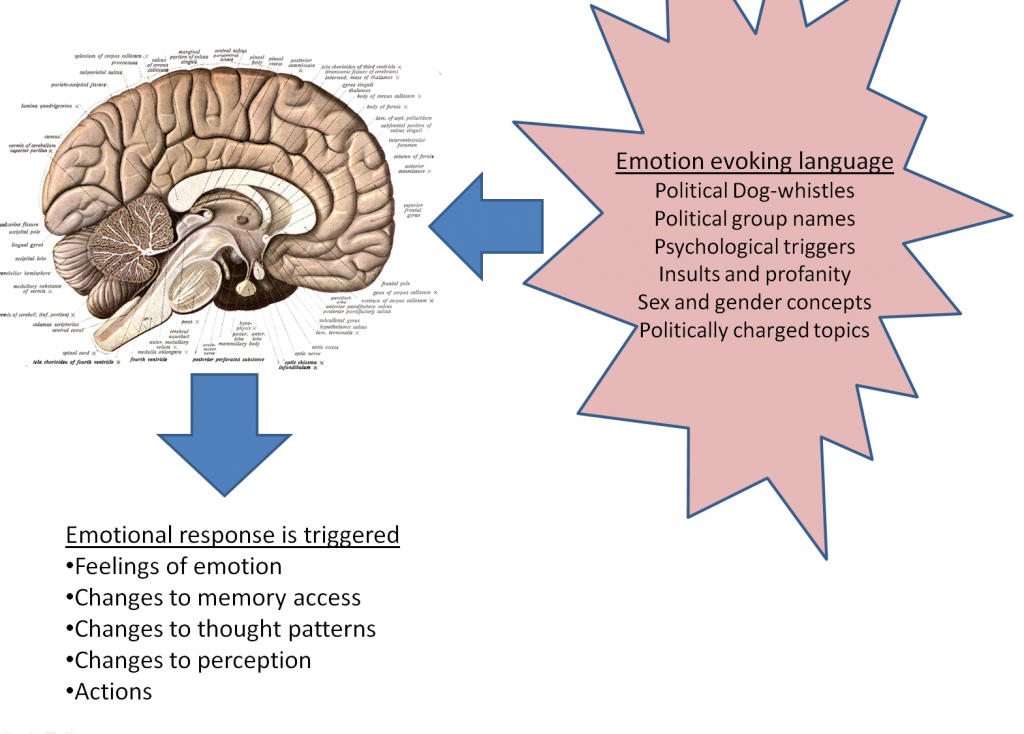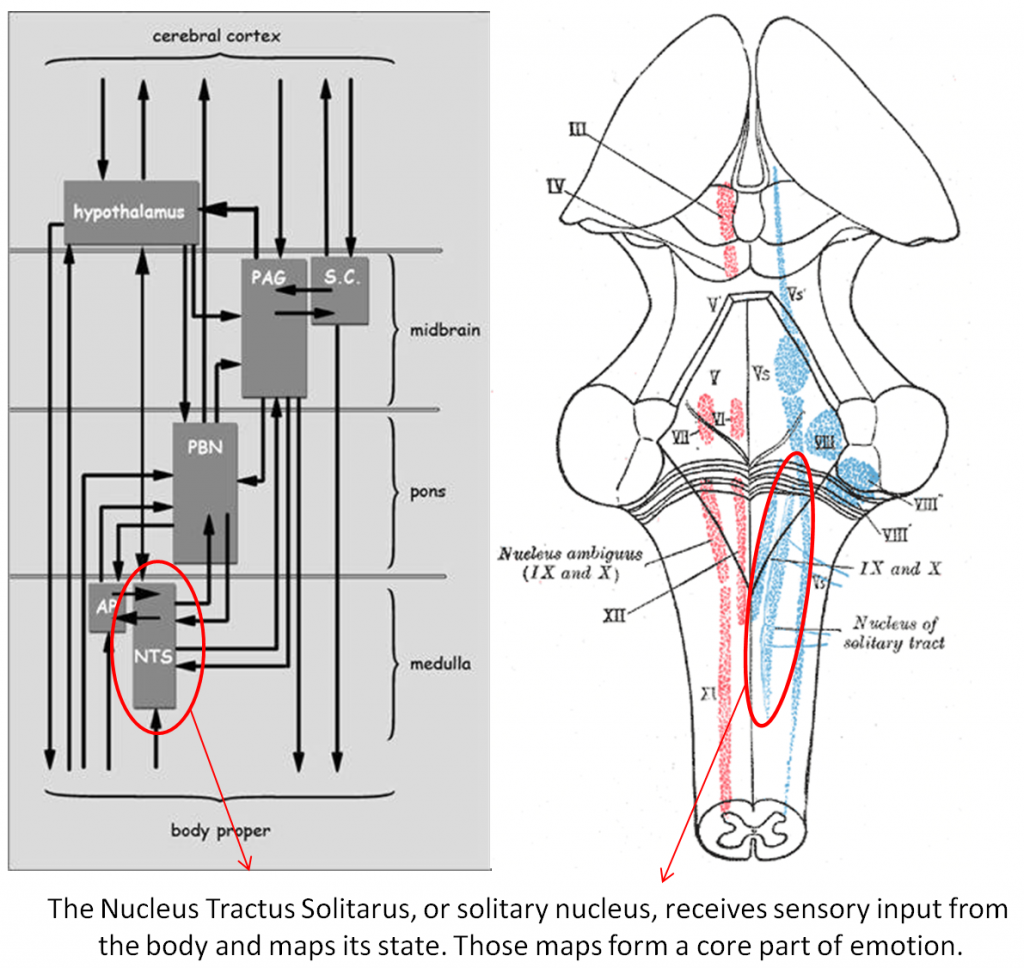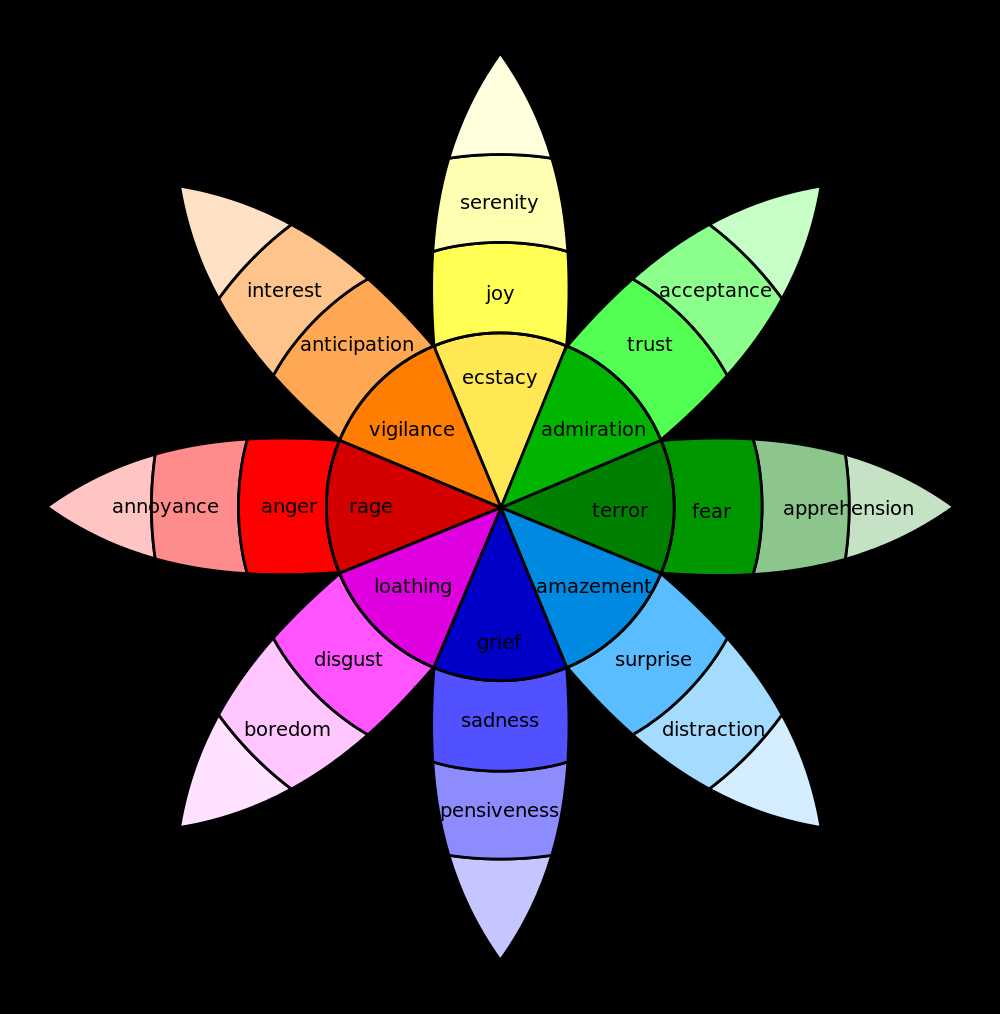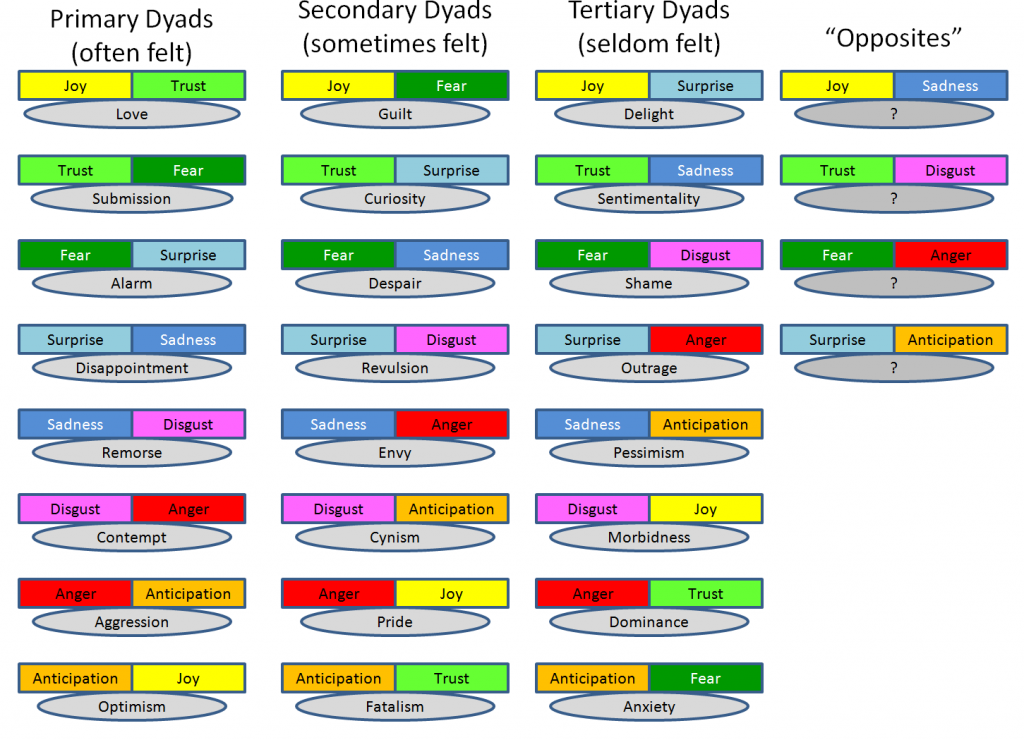I’ve been delayed on my next post related to social conflict, my job has taken quite a bit of energy from me. That is what has been on my mind for the most part lately but I do have something that I can introduce so that those of you that want can at least get into the sources of information that I am going to use. After that I’m going to talk about work a little bit at the end because I need to do that, it has to do with conflict too and how I’ve been getting a real-world education in things I have been dabbling with. In some ways I’ve had to suppress the way I think about things related to what I write about in order to develop good habits with what I do and that has slowed things down.
But I have been able to flesh out the beginning now that I have a list of things that I was able to organize into important concepts to cover. I want to start with perception and emotion. The way that I see conflict involves what people do with their words, “text-actions”. People approach and withdraw from parts of what the other says, interacts with it in different ways, and in that you can pick up information from what they choose to engage with. And what they avoid, often what they strategically avoid. In my studies about myself and human behavior in general I have encountered some information that can put these actions into an understandable framework. From that basis individual actions and strategies can be explained and outlined.
So with that in mind I have an outline for my first set of posts.
1) Perception and the conscious experience of emotion in language.
- A) Perception: The assembly of the reality we react to.
- B) Emotion: Experience based motivation to action.
- C) Emotion in language: A framework for the identification of social conflict actions and strategies in language.
Perception and the conscious experience of emotion in language.
I think that it’s Important to give an outline of how we perceive and react to reality before I get specific on the various strategies used by individuals in the different sides of a social conflict. There is a whole lot of bullshit in the rhetoric that advantages people in power, and since rhetoric is the part of language that has to do with winning and not being correct about reality in a social conflice this is an important frame to have before advancing.
A lot of that rhetoric revolves around:
*Confusing the feeling of emotion with the things that emotion is attached to in every single human being, the experiences and perspectives that resulted in that emotional reaction.
This results in emphasizing the presence of emotion and ignoring the non-emotional content. Functionally this is often done by accusing others of being “irrational”. There are also group-specific example like calling passionate women “hysterical”.
*Pretending that normal human actions, interactions and reactions are abnormal for strategic purposes.
Instead of looking at the reasons for outrage some people act like the outrage itself is a problem. Instead of looking at why a community is all acting like something is true some people use the pejorative “hivemind”. Instead of looking at why one person is coming to the aid of another they use the pejorative “white knight”.
*Responding to the emotion in language as elements that indicate attacks, defenses, deceptions and obfuscations. These come in conscious and unconscious varieties and quite a few of them have to do with in-group feelings being accepted as convincing evidence even when irrational or illogical.
…and we will probably find other examples as we move on.
The function of the brain and mind are an ongoing area of research but we do know a lot that is useful making regular interactions more sensible. So while I am confident in how I am using these resources it’s still important to know that these things are subject to change as we learn more. I’m going to combine the information presented by the two sources into a model of how language is perceived and reacted to that can form a basis for more work.
Source one:”Self Comes to Mind: Constructing the Conscious Brain” by Antonio Damasio.
This book has been tremendously valuable to me when it comes to integrating a lot of other things I have learned about brain science. In this book the author, a neurobiologist from Portugal, outlines how consciousness is thought to be constructed in a tour through anatomy and function.
Highlights include the hypothetical origins of value from the very origins of life, the origin of mind from creatures acting based on dispositions newly capable of mapping the world, and the origin of the self in mind bearing creatures that could understand themselves as knowers. This book also includes a lot of information about brain anatomy involved in consciousness and examples of people with conditions and damage that have informed our knowledge about how parts of anatomy contribute when their function is altered or absent.
The topics that is most useful in understanding the perception of conflict in text is the nature and function of emotion. While popular culture likes to emphasize the feeling of emotion, emotion is in reality composed of at least five components:

From “Sobotta’s Human Anatomy” 1908
1) Feelings of emotion (sensed changes to metabolism and alert status in the body, the body forms the core of emotion).
Relevant to: content related to feeling which is useful in rhetoric, attempts to emphasize or deemphasize connections to the remaining components of emotion, and empathy when accepting and feeling with another person.
2) Changes to how memory is read/written to (based on past experience relevant to what one is perceiving).
Relevant to: how a person’s experiences are connected to what they are reacting to, persons, places, things, events, and other things they choose to include explicitly and implicitly in their actions and reactions.
3) Changes to how thought is shaped and directed (how one reasons and logics, what one reasons and logics about such as motivated reasoning).
Relevant to: motivated reasoning, bias (rational and irrational), fallacious thought, skeptical thought, logical thought, distorted thought, xenophobic and bigoted thought and more.
4) Changes to how perception is shaped and directed (what one focuses on and what one can and will contextually connect to that).
Relevant to: psychological triggers that prompt strong and/or specific actions/reactions (trauma triggers, political “dog-whistles”, names of people, groups, concepts that rouse strong emotions…), over-focusing and under-focusing on parts of an argument, focusing on irrelevant common features that can lead to conspiracy-like thinking and more.
5) Actions that consist of responses to what we perceive and holding actions as we wait for responding actions (Actions that are based on current needs and motivations and that are deemed proper based on past experience and current knowledge of the situation, communications are actions here)
Relevant to: discussions, arguments, fights, attacks, defenses, deception and obfuscation, comparisons, contrasts, emphases, deemphases and other expression of 1-4.
While these all occur in individuals a social factor is tied into all of it that involves efficiency, effectiveness, strength, and nature of how all of these are established. The social variable is one that is very often and even deliberately misunderstood and ignored in how social conflict is shaped, especially among people who stand to benefit from neglecting or ignoring the effects that we have on one another individually and in groups.
Sex and gender applications.
As a final note at some point I want to also use the material in “Self Comes to Mind: Constructing the Conscious Brain” to address sex and gender issues because there is a framework here that can be applied to how emotion relates to the body through our language. These are my own thoughts about the material and what I hear other people speak of.
It turns out that feelings from the body is a basic part of emotion (primordial self) along with incoming sensory information that modifies the body component (core self), and that the anatomical substance that forms this core are brainstem nuclei (parabrachial nucleus, nucleus tractus solitarius) that continuously map the body and its current state. These body maps are not only modified by the state of the body itself, but also by our memory (simulated body states), and our experiences which include our social experiences.

Left side: From “Self Comes to Mind”, figure 4.1. Right side: From “Grey’s Anatomy” and used in Wikipedia entry on the solitary nucleus.
While I’m not quite sure how to approach this best, it seems to me that this is a prime candidate for how our experiences (personal and social) modify our emotional relationship with our own bodies and how the symbolism related to male and female can be tied to language. This is likely a necessary substrate for how we create social messages that relate to who and what male and female people are and supposed to be and do. While this picture emphasizes material that seem to relate to the social construction of sex and gender I have to emphasize that there are phenomena that include that amount to predispositions towards some gender expressions over others. It can’t be assumed that gender is totally hardwired or totally socially programmed for male and female people individually or as a group based on what I know.
Naturally this will be an area where the perspectives of many different people will be required to get a complete picture. I know how I feel about myself, how I feel about societies messages, but I’m not in a group that feels inconsistency and wrongness to a level that require things like preferred pronouns that are different than historical norms and more. The perspectives of others are more important and so I want to present this carefully.
Source two: Robert Plutchick‘s Psychoevolutionary Theory of Emotion.
While I do not have a hard copy of the source for this theory (yet), I have found enough useful material online to get started in using the information provided by it.
According to Plutchik’s work there are eight basic emotional states and each one is associated with a specific action and feeling. There may be individual level and a social level versions of each of them as there most certainly is for disgust (this become more obvious with trust after the list). Note that I am providing my own version of the stated actions and in some cases these are different than what is in the links. I’ll explain that in the post dedicated to each topic (In fact my own way of looking at material is present in many areas and I’m making sure I’m able to point it out and explain it when it occurs).
*Anger: Destruction or other negation of an obstacle.
*Anticipation: Interaction with awareness, reaction to familiar contact.
*Joy: Gain of resources.
*Trust: “Social feeding” or “social ingestion” into one’s in-group (see explanation below).
*Fear: Prevention of personal destruction.
*Surprise: Exploratory interaction, reaction to unfamiliar contact.
*Sadness: Loss of resources.
*Disgust: Expulsion or ejection from social group.
These exist as four pairs of “computational opposites”, and a common way of displaying them is Plutchik’s wheel of emotions (figure below). The most familiar is the [Anger-Fear] pair that works as a “fight or flight” spectrum. The others are [Anticipation-Surprise] (knowing vs. unknowing interaction), [Joy-Sadness] (gain vs. loss of resources), and the weird one represented by [Trust-Disgust]. That last one is weird because it’s not readily obvious that social trust is a kind of consumptive process, but that makes sense given the fact that social disgust is a modification of physical disgust (physical ejection to social ejection). But consider that primates spend time grooming and eating parasites off of one another and how food is so deeply integrated into our social interactions.

Robert Plutchik’s wheel of emotions (from Wikipedia). Each axis is a pair of opposites in terms of a characteristic associated with an action relative to the individual feeling the emotion. “Other destruction-self destruction” for anger-fear, “gain resources-loss resources” for joy-sadness, “interaction w/ known-interaction w/ unknown” with anticipation-surprise, and “accept to self-reject from self” with trust-disgust. Each “spoke” of the wheel also exists in a range of intensities with the names emotion taking a middle intensity.
While there are other theories that use six basic emotional states (or other numbers), and organize them by different characteristics, this is the model I prefer until another one comes along that explains reality better. These basic emotional states combine with one another into more complex emotions like combining paints into more colors (google emotional dyads and Plutchik and some neat graphics are in google images). For example Love = Joy +Trust, and Shame = Fear + Disgust. The emotional dyads are things I would be adding in at a later time though because that might make things too complex for now. (I think those “Opposites” have to do with humor related transformations).

This theory of emotion is very useful for visualizing emotion in language, basically looking for language that directly implies an emotion by what the language functionally does. Most social conflict involves treating something as an obstacle to be overcome, defeating an argument is removing it as an obstacle, destroying a threat. Thus anger is a very large part of the language of social conflict and this is a thing that is natural and neutral in an abstract sense. It’s reasonable to want a threatening thing to be gone, but if the thing is truly threatening is often why there is an argument. Fear is a close second to anger in conflict language that outlines things that can cause harm. Disgust after that in the implications that outline rejection of beliefs, thoughts, behaviors, and people from personal association.
My experiences in the real world of mental health employment.
I’ve spent the last seven years reading and learning about how brains make minds and how individual differences are shaped. This is firstly been used to benefit myself as I learn about how my brain and mind work, and secondly as a means of learning about people in general. I’ve also seen what happens when people speak too casually and irresponsibly about brain science as prominent members of the atheist community have used references to incomplete knowledge and stereotypes to excuse bad behavior or reject what some people have to say. As a result I have become very careful about how I talk about what I’ve learned, the assumptions I make with the knowledge I have, and the actions I take based on those assumptions. This new job has required me to apply this care in using what I know in another way.
I’m not a psychologist or a psychiatrist. I’m not a neurobiologist. I’m not some expert in brain science, I’m a technician. My job is to help create a social structure around 16 male people between the ages of 13-17. My job is to maintain a rigid “social normal” with clear expectations that keeps everyone safe where the patents know what they need to do to “stay on program”. My job is not to use all of that stuff that has been my hobby for the last seven years. In fact I have to put it all in a box in the back of my mind and focus on maintaining what is already here while other specialists do their jobs. Until I know my job well I do not get creative, I am emphasizing doing what the other technicians do. In many ways it’s a lot like the substitute teacher job that I had but without the negatives which were lack of institutional support and a daily sense of being the new authority figure to challenge. Now I can get to know the same group of people and I have a lot of support.
There is a fairly strict daily routine routine, the patients know what they need to do, and when they don’t do what they are supposed to or do something they are not supposed to there are consequences that can result in loss of privileges. I do things like open up locked closets so patients can get their rooms ready for daily cleanliness and organization checks. I tell them when they need to get their laundry ready, or when it’s their turn for a shower. I monitor the bathroom while they are in there to make sure there is no trouble. I make sure they get into lines facing the same direction and don’t talk to one another while we transition to another place (like the cafeteria) or activity because fights and other chaos results. I choose group activities that occur when they get back from school and they are supposed to participate without excessive talking, or they can stay in their rooms (while engaging in non-disruptive activities) if they don’t like the activity.
These children are here for impulse control problems, emotion and mood problems, antisocial and oppositional behavior, and other issues. Some have been abused and some are abusers. Some have committed murder. I have to maintain an environment and routine around them that keeps us all safe and creates clear expectations. If my job is done then the work they do with their therapists and other specialists can be effective. In fact the structure I maintain around them is part of the therapy. Thinking of and awareness of expectations, empathy for others, the health of the group are things these children do not do and have well.
I have received training in dealing with being attacked and putting patients into holds. The unit I work in has a seclusion room that is a last resort for dealing with an imminent threat from a patient. I have been threatened and I have had a patient take a swing at me but I have not yet been attacked. Last week I participated in putting a violent patient into a hold. I have been living a world of brain-science abstractions and now I am confronted with the real-world of problems involving human behavior. It’s serious shit. If these children fail their programs and turn 18 many of them have parents that don’t want them to come back, if they have parents. And some of those children won’t have group homes either. Their prospects are very grim. If I fail at doing my job they don’t get to work on what they need to work on.
So I’ve had to control how I think about social conflict because my job is about preventing it in many ways. It has slowed things down, but for good reason. Wanting to “win” is a bad instinct in this job as a goal is avoiding power struggles all together. This job will teach me some new skills and I will become stronger because of it. But for now It’s hard to anticipate what will happen and what I will have to learn to control. It is what it is until I know enough to be unique.
